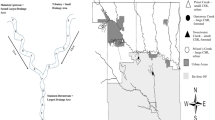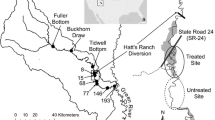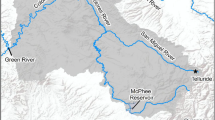Abstract
The response of rivers and riparian forests to upstream dams shows a regional pattern related to physiographic and climatic factors that influence channel geometry. We carried out a spatial analysis of the response of channel geometry to 35 dams in the Great Plains and Central Lowlands, USA. The principal response of a braided channel to an upstream dam is channel-narrowing, and the principal response of a meandering channel is a reduction in channel migration rate. Prior to water management, braided channels were most common in the southwestern Plains where sand is abundant, whereas meandering channels were most common in the northern and eastern Plains. The dominant response to upstream dams has been channel-narrowing in the southwestern Plains (e.g., six of nine cases in the High Plains) and reduction in migration rate in the north and east (e.g., all of twelve cases in the Missouri Plateau and Western Lake Regions). Channel-narrowing is associated with a burst of establishment of native and exotic woody riparian pioneer species on the former channel bed. In contrast, reduction in channel migration rate is associated with a decrease in reproduction of woody riparian pioneers. Thus, riparian pioneer forests along large rivers in the southwestern Plains have temporarily increased following dam construction while such forests in the north and east have decreased. These patterns explain apparent contradictions in conclusions of studies that focused on single rivers or small regions and provide a framework for predicting effects of dams on large rivers in the Great Plains and elsewhere. These conclusions are valid only for large rivers. A spatial analysis of channel width along 286 streams ranging in mean annual discharge from 0.004 to 1370 cubic meters per second did not produce the same clear regional pattern, in part because the channel geometries of small and large streams are affected differently by a sandy watershed.
Similar content being viewed by others
Literature Cited
Akashi, Y. 1988. Riparian vegetation dynamics along the Bighorn River, Wyoming. Masters Thesis. University of Wyoming, Laramie, WY, USA.
Albertson, F. W. and J. E. Weaver. 1945. Injury and death or recovery of trees in prairie climate. Ecological Monographs 15:395–433.
Anderson, B. W. 1971. Man’s influence on hybridization in two avian species in South Dakota. Condor 73:342–347.
Auble, G. T. and M. L. Scott. 1998. Fluvial disturbance patches and cottonwood recruitment along the upper Missouri River. Montana. Wetlands 18:546–556.
Bergman, D. L. and C. W. Sullivan. 1963. Channel changes on Sandstone Creek near Cheyenne. Oklahoma. U.S. Geological Survey Professional Paper 475-C.
Bradley, C. E. and D. G. Smith. 1984. Meandering channel response to altered flow regime: Milk River, Alberta and Montana. Water Resources Research 20:1913–1920.
Bradley, C. E. and D. G. Smith. 1986. Plains cottonwood recruitment and survival on a prairie meandering river floodplain, Milk River, southern Alberta and northern Montana. Canadian Journal of Botany 64:1433–1442.
Bragg, T. B. and A. K. Tatschl. 1977. Changes in flood-plain vegetation and land use along the Missouri River from 1826 to 1972. Environmental Management 1:343–348.
Brinson, M. M., B. L. Swift, R. C. Plantico, and J. S. Barclay. 1981. Riparian ecosystems: their ecology and status. U.S. Fish and Wildlife Service Biological Services Program, Washington, DC, USA. FWS/OBS-81/17.
Brock, J. H. 1994.Tamarix spp. (Salt Cedar), an invasive exotic woody plant in arid and semi-arid riparian habitats of western USA. p. 27–44.In L. C. de Waal, L. E. Child, P. M. Wade, and J. H. Brock (eds.) Ecology and Management of Invasive Riverside Plants. John Wiley and Sons, Ltd., New York, NY, USA.
Bruner, W. E. 1931. The vegetation of Oklahoma. Ecological Monographs 1:99–188.
Burger, L. D., L. W. Burger, Jr., and J. Faaborg. 1994. Effects of prairie fragmentation on predation on artificial nests. Journal of Wildlife Management 58:249–254.
Church, M. 1995. Geomorphic response to river flow regulation: case studies and time-scale. Regulated Rivers: Research and Management 11:3–22.
Crouch, G. L. 1979. Long-term changes in cottonwoods on a grazed and an ungrazed plains bottomland in northeastern Colorado. U.S. Forest Service, Rocky Mountain Forest and Range Experiment Station, Fort Collins, CO, USA. Research Note RM-370.
Currier, P. J. 1982. The floodplain vegetation of the Platte River: phytosociology, forest development, and seedling establishment. Ph.D. Dissertation. Iowa State University, Ames, IA, USA.
Dynesius, M. and C. Nilsson. 1994. Fragmentation and flow regulation of river systems in the northern third of the world. Science 266:753–762.
Environmental System Research Institute, Inc. 1992. AreUSA 1:2M. CD-ROM. Environmental System Research Institute, Inc., Redlands, CA, USA.
Environmental System Research Institute. Inc. 1997. Arc/Info version 7.1.1. Environmental System Research Institute, Inc., Redlands, CA, USA.
Everitt, B. L. 1968. Use of the cottonwood in an investigation of the recent history of a flood plain. American Journal of Science 266:417–439.
Fenneman, N. M. and D. W. Johnson. 1946. Physical divisions of the United States. Map, 1∶7,000,000. U.S. Geological Survey Washington, DC, USA. Physiographic divisions of the conterminous United States Online. http://nsdi.usgs.gov/nsdi/wais/water/ physio.HTML. 18 June 1997.
Finch, D. M. 1989. Habitat use and habitat overlap of riparian birds in three elevational zones. Ecology 70:866–880.
Frémont, J. C. 1988. The Exploring Expedition to the Rocky Mountains. Smithsonian Institute Press, Washington, DC, USA.
Friedman, J. M., W. R. Osterkamp, and W. M. Lewis, Jr. 1996. Channel narrowing and vegetation development following a Great-Plains flood. Ecology 77:2167–2181.
Friedman, J. M., M. L. Scott, and G. T. Auble. 1997. Water management and cottonwood forest dynamics along prairie streams. p. 49–71.In F. J. Knopf and F. B. Samson (eds.) Ecology and Conservation of Great Plains Vertebrates. Springer-Verlag, New York, NY, USA.
Friedman, J. M., M. L. Scott, and W. M. Lewis, Jr. 1995. Restoration of riparian forest using irrigation, artificial disturbance, and natural seedfall. Environmental Management 19:547–557.
Funk, J. L. and J. W. Robinson. 1974. Changes in the channel of the lower Missouri River and effects on fish and wildlife. Missouri Department of Conservation Aquatic Series No. 11, Jefferson City, MO, USA.
Gillespie, B. M. and J. R. Giardino. 1996. Determining the migratory activity index for a river: an example from the Brazos River. Texas. Zeitschrift fur Geomorphologie 40:417–428.
Great Plains Flora Association. 1986. Flora of the Great Plains. University Press of Kansas, Lawrence, KS, USA.
Hallberg, G. R., J. M. Harbaugh, and P. M. Witniok. 1979. Changes in the channel area of the Missouri River in Iowa, 1879–1976. Iowa Geological Survey, Iowa City, IA, USA. Special Report Series No. 1.
Hefley, H. M. 1937. Ecological studies on the Canadian River flood plain in Cleveland County, Oklahoma. Ecological Monographs 7: 345–402.
Hitt, K. 1984. Surface-water and related-land resources development in the United States and Puerto Rico. Map, 1∶3,168,000 scale. U. S. Geological Survey, Reston, VA, USA.
Horton, J. S., F. C. Mounts, and J. M. Kraft. 1960. Seed germination and seedling establishment of phreatophyte species. U.S. Forest Service, Rocky Mountain Forest and Range Experiment Station, Fort Collins, CO, USA. Paper No. 48.
Hunt, C. B. 1979. Surficial Geology. Map. 1∶7,500,000 scale. National Atlas of the United States of America, U.S. Geological Survey, Reston, VA, USA.
Johnson, W. C. 1992. Dams and riparian forests: case study from the upper Missouri River. Rivers 3:229–242.
Johnson, W. C. 1994. Woodland expansion in the Platte River, Nebraska: patterns and causes. Ecological Monographs 64:45–84.
Johnson, W. C. 1998. Adjustment of riparian vegetation to river regulation in the Great Plains, USA. Wetlands 18:608–618.
Johnson, W. C., R. L. Burgess, and W. R. Keammerer. 1976. Forest overstory vegetation and environment on the Missouri River floodplain in North Dakota. Ecological Monographs 46:59–84.
Johnson, W. C., H. D. Cantwell, and T. A. Dean. 1980. The impact of agricultural settlement on Canadian Sandy Creek, Oklahoma. Proceedings of the Oklahoma Academy of Sciences 60:82–88.
Jordan, P. R. 1982. Rainfall-runoff relations and expected streamflow in western Kansas. Kansas Water Office, Topeka, KS, USA. Bulletin Number 25.
Knopf, F. L. 1986. Changing landscapes and the cosmopolitism of the eastern Colorado avifauna. Wildlife Society Bulletin 14:132–142.
Knopf, F. L. 1992. Faunal mixing, faunal integrity, and the biopolitical template for diversity conservation. Transactions of the North American Wildlife and Natural Resources Conference 57: 330–342.
Knox, J. C. 1977. Human impacts on Wisconsin stream channels. Annals of the Association of American Geographers 67:323–342.
Kolberg, F. J. and A. D. Howard. 1995. Active channel geometry and discharge relations of U.S. piedmont and midwestern streams: the variable exponent model revisited. Water Resources Research 31:2353–2365.
Kromm, D. E. and S. E. White. 1992. Groundwater problems. p. 44–63.In D. E. Kromm and S. E. White (eds.) Groundwater Exploitation in the High Plains. University of Kansas Press, Lawrence, KS, USA.
Lane, E. W. 1957. A study of the shape of channels formed by natural streams flowing in erodible material. U.S. Army Engineer Division, Missouri River, Corps of Engineers, Omaha, NE, USA. M. R. D. Sediment Series No. 9.
Larner, D. C., R. M. Marshall, A. E. Pfluger, and S. C. Burnitt. 1974. Woody phreatophytes along the Colorado River from southeast Runnels County to the headwaters in Borden County, Texas. Texas Water Development Board, Austin, TX, USA. Report 182.
Leopold, L. B. and T. Maddock, Jr. 1953. The hydraulic geometry of stream channels and some physiographic implications. U.S. Geological Survey Professional Paper 252.
Leopold, L. B. and M. G. Wolman. 1957. River channel patterns: braided, meandering and straight. U.S. Geological Survey Professional Paper 282-B.
Lindauer, I. E. 1983. A comparison of the plant communities of the South Platte and Arkansas River drainages in eastern Colorado. Southwestern Naturalist 28:249–259.
Luckey, R. R., E. D. Gutentag, F. J. Heimes, and J. B. Weeks. 1988. Effects of future ground-water pumpage on the High Plains Aquifer in parts of Colorado, Kansas, Nebraska, New Mexico, Oklahoma, South Dakota, Texas, and Wyoming. U.S. Geological Survey Professional Paper 1400-E.
Madole, R. F. 1995. Spatial and temporal patterns of late Quaternary colian deposition, eastern Colorado, U.S.A. Quaternary Science Reviews 14:155–177.
Magilligan, F. J. 1985. Historical floodplain sedimentation in the Galena River Basin, Wisconsin and Illinois. Annals of the Association of American Geographers 75:583–594.
Miller, J. R., T. T. Schulz, N. T. Hobbs, K. R. Wilson, D. L. Schrupp, and W. L. Baker. 1995. Changes in the landscape structure of a southeastern Wyoming riparian zone following shifts in stream dynamics. Biolgoical Conservation 72:371–379.
Moss, E. H. 1938. Longevity of seed and establishment of seedlings in species ofPopulus. Botanical Gazette 99:529–542.
Nanson, G. C. and J. C. Croke. 1992. A genetic classification of floodplains. Geomorphology 4:459–486.
Osterkamp, W. R. 1978. Gradient, discharge, and particle-size relations of alluvial channels in Kansas, with observations on braiding. American Journal of Science 278:1253–1268.
Osterkamp, W. R., M. M. Fenton, T. C. Gustavson, R. F. Hadley, V. T. Holliday, R. B. Morrison and T. J. Toy. 1987. Great Plains. p. 163–210.In W. L. Graf (ed.) Geomorphic Systems of North America. Geological Society of America, Boulder, CO, USA. Centennial Special Volume 2.
Osterkamp, W. R. and E. R. Hedman. 1981. Channel geometry of regulated streams in Kansas as related to mean discharge, 1970–1980. Kansas Water Office, Topeka, KS, USA. Technical Report No. 15.
Osterkamp, W. R. and E. R. Hedman. 1982. Perennial-streamflow characteristics related to channel geometry and sediment in Missouri River Basin. U.S. Geological Survey Professional Paper 1242.
Osterkamp, W. R., E. R. Hedman, and A. G. Wiseman. 1982. Geometry, basin-characteristic, discharge, and particle-size data from gaged stream-channel sites, western United States. U.S. Geological Survey Hydrologic Data Open-File Report 82-93.
Petts, G. E. 1979. Complex response of river channel morphology subsequent to reservior construction. Progress in Physical Geography 3:329–362.
Read, R. A. 1958. The Great Plains shelterbelts in 1954. Great Plains Agricultural Council, Lincoln, NE, USA. Publication No. 16.
Rood, S. B., C. Hillman, T. Sanche, and J. M. Mahoney. 1994. Clonal reproduction of riparian cottonwoods in southern Alberta. Canadian Journal of Botany 72:1766–1770.
Rood, S. B., A. R. Kalischuk, and J. M. Mahoney. 1998. Initial cottonwood seedling recruitment following the flood of the century of the Oldman River, Alberta, Canada. Wetlands 18:557–570.
Rood, S. B. and J. M. Mahoney. 1990. Collapse of riparian poplar forests downstream from dams in western prairies: Probable causes and prospects for mitigation. Environmental Management 14:451–464.
Rood, S. B. and J. M. Mahoney. 1995. River damming and riparian cottonwoods along the Marias River, Montana. Rivers 5:195–207.
Rood, S. B., J. M. Mahoney, D. E. Reid, and L. Zilm. 1995. Instream flows and the decline of riparian cottonwoods along the St. Mary River, Alberta. Canadian Journal of Botany 73:1250–1260.
Schumm, S. A. 1960. The shape of alluvial channels in relation to sediment type. U.S. Geological Survey Professional Paper 352-B.
Schumm, S. A. 1977. The Fluvial System. Wiley-Interscience, New York, NY, USA.
Schumm, S. A. and R. W. Lichty. 1963. Channel widening and floodplain construction along Cimarron River in southwestern Kansas. U.S. Geological Survey Professional Paper 352-D.
Scott, M. L., G. T. Auble, and J. M. Friedman. 1997. Flood dependency of cottonwood establishment along the Missouri River, Montana, USA. Ecological Applications 7:677–690.
Scott M. L., J. M. Friedman, and G. T. Auble. 1996. Fluvial process and the establishment of bottomland trees. Geomorphology 14:327–339.
Scott, M. L., M. A. Wondzell, and G. T. Auble. 1993. Hydrograph characteristics relevant to the establishment and growth of western riparian vegetation. p. 237–246.In H. J. Morel-Seytoux (ed.) Proceedings of the 13th Annual American Geophysical Union Hydrology Days. Hydrology Days Publications, Atherton, CA, USA.
Segelquist, C. A., M. L. Scott, and G. T. Auble. 1993. Establishment ofPopulus deltoides under simulated alluvial groundwater declines. American Midland Naturalist 130:274–285.
Smith, D. G. 1976. Effect of vegetation on lateral migration of anastomosed channels of a glacial meltwater river. Geological Society of America Bulletin 87:857–860.
Smith, D. G. 1979. Effects of channel enlargement by river ice processes on bankfull discharge in Alberta, Canada. Water Resources Research 15:469–475.
Smith, N. D. and D. G. Smith. 1984. William River: an outstanding example of channel widening and braiding caused by bed load addition. Geology 12:78–82.
Snyder, W. D. and G. C. Miller. 1991. Changes in plains cottonwoods along the Arkansas and South Platte rivers —eastern Colorado. Prairie Naturalist 23:165–176.
Stanford, J. A., J. V. Ward, W. J. Liss, C. A. Frissell, R. N. Williams, J. A. Lichatowich, and C. C. Countant. 1996. A general protocol for restoration of regulated rivers. Regulated Rivers: Research and Management 12:391–413.
Stinnett, D. P., R. W. Smith, and S. W. Conrady. 1988. Riparian areas of western Oklahoma: a case study of the Canadian River. p. 22–29.In P. J. Stuber (coord.) Proceedings of the National Symposium on Protection of Wetlands from Agricultural Impacts. U.S. Fish and Wildlife Service, Washington, DC, USA. Biological Report 88(16).
Teskey, R. O. and T. M. Hinckley. 1978. Impact of water level changes on woody riparian and wetland communities; Vol. VI: Plains grassland region. U.S. Fish and Wildlife Service, Biological Services Program, Washington, DC, USA. FWS/OBS-78/89.
Tomelleri, J. R. 1984. Dynamics of the woody vegetation along the Arkansas River in western Kansas, 1870–1983. Masters Thesis. Fort Hays State University, Hays, KS, USA.
Trimble, S. W. and S. W. Lund. 1982. Soil conservation and the reduction of erosion and sedimentation in the Coon Creek Basin, Wisconsin. U.S. Geological Survey Professional Paper 1234.
United States Department of Agriculture. 1981. Soil, water, and related resources in the United States: status, condition, and trends, 1980 Appraisal, Part I. U.S. Department of Agriculture, Washington DC, USA.
Ware, G. H. and W. T. Penfound. 1949. The vegetation of the lower levels of the floodplain of the South Canadian River in central Oklahoma. Ecology 30:478–484.
Weaver, J. E. 1960. Flood plain vegetation of the central Missouri valley and contacts of woodland with prairie. Ecological Monographs 30:37–64.
Wharton, G. 1995. The channel-geometry method: guidelines and applications. Earth Surface Processes and Landforms 20:649–660.
White, P. S. 1979. Pattern, process, and natural disturbance in vegetation. Botanical Review 45:229–299.
Whitesell, B. L., J. D. Vitek, and D. R. Butler. 1988. Changes in the planform of the Red River, McCurtain County, Oklahoma, 1938–84. Oklahoma Geology Notes 48:196–211.
Williams, G. P. 1978. The case of the shrinking channels —the North Platte and Platte rivers in Nebraska. U.S. Geological Survey Circular 781.
Williams, G. P. and M. G. Wolman. 1984. Downstream effects of dams on alluvial rivers. U.s. Geological Survey Professional Paper 1286.
Wolman, M. G. and R. Gerson. 1978. Relative scales of time and effectiveness of climate in watershed geomorphology. Earth Surface Processes 3:189–208.
Author information
Authors and Affiliations
Rights and permissions
About this article
Cite this article
Friedman, Osterkamp, W.R., Scott, M.L. et al. Downstream effects of dams on channel geometry and bottomland vegetation: Regional patterns in the great plains. Wetlands 18, 619–633 (1998). https://doi.org/10.1007/BF03161677
Received:
Revised:
Accepted:
Issue Date:
DOI: https://doi.org/10.1007/BF03161677




